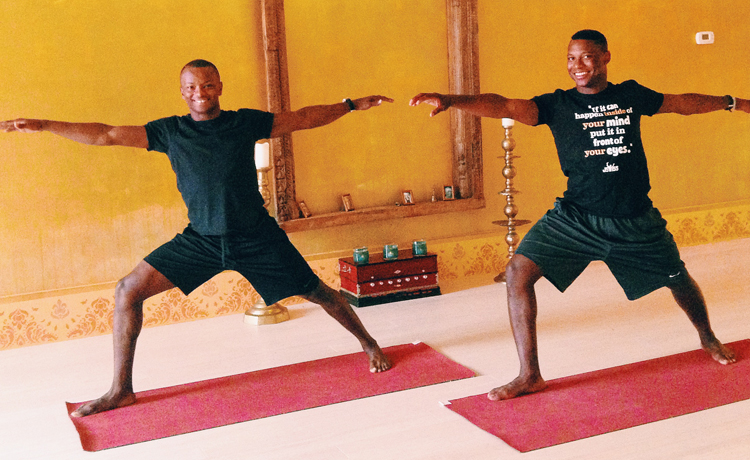
May the Force Be With You
By YSNY Teachers, August, 2016
Dear Friends,
If you’ve been to class with Colleen and Rodney lately, you’ve probably heard them say, “Don’t Force.” What a great instruction to consider for August!
The 2016 Summer Olympics are upon us. Consider the rigorous, disciplined schedules and lifestyles of those athletes. Consider the goals they must set for themselves. But when they force themselves beyond their limits, there’s no doubt they’re met with exhaustion, injuries, and other obstacles that stand in the way of their goals. Olympic athletes, like our friends Daryl Homer and Jean-Paul Tony-Helissey (pictured in virabhadrasana II above), train to win, but in doing so, they train to go with the flow.
We looked up “force” in the dictionary, and there are over 36 definitions. So context is everything. We’ve decided to take a deeper look at this instruction for the month, and we hope you’ll join us in the inquiry.
The question is, How have you applied the instruction “Don’t Force” to your life?
Joyce Englander Levy says, “In general, I think the instruction is meant to steer us away from the kind of overpowering that would force a false confession, so to speak. Do you ever force yourself to do something in your practice and your life, and it feels false? I think this is the kind of force we’d like to encourage away from. Yoga practice is all about balancing opposing forces so that we can feel a sense of ease flowing through the center of the pose — or, even better, the center of our lives.”
Jamie Lugo agrees that “Don’t force,” is one of her favorite mantras. She says, “It has influenced my practice and teaching greatly. It’s a phrase I like to remind myself of daily. ‘Force’ can come in a lot of shapes and sizes but to me it means to not get in the way of the natural progression of things. When we try too hard, especially in our practice, we can end up building dams instead of rivers — for example, an injury instead of a breakthrough. In that respect, there’s a lot of observation that needs to take place in order to see what patterns and cycles already exist.”
Jamie continues, “J. Krishnamurti said, ‘Observation is action.’ And what a relief that is. Maybe no force is necessary. People seem so hell-bent on changing the world around us and within us. But my teaching recently has been about allowing the natural patterns to come up, and then observing them. Because how can we change something if we don’t know what already exists? In that observation we can ask ourselves, Am I getting in my own way, or am I encouraging a natural current? Can I redirect this pattern instead of replacing it with another one? It’s like waiting for a phone call: You wait, you wait, and you wait. But when you forget all about it, that’s when the phone rings.”
The whole idea behind “Don’t Force” is to be more fully yourself. As Keely Garfield points out, discipline is a key ingredient in living a yogic life. She says, “You could make the case that in fact I do force myself to roll out that mat, practice, sit, self-reiki, talk to a friend. I think of this kind of ‘force’ as paying attention, or concentrating. When I was a little girl, I had to force myself to drink that medicine that tastes disgusting because ultimately I knew it was good for me. Knowing when to ease off is one thing, but I have to be able to apply the pedal when necessary!”
Having the discipline to show up, dig deep, and be present, is vital to steering a spiritual life. How can we get out of our own way? How can we balance being organized, aligned, disciplined, and easygoing so that we can feel like the best versions of ourselves in this world that needs our best, without feeling like we’re over-efforting?
It’s difficult not to use force when we have goals and a vision for our lives. But what kind of force are we applying? Is it actually helping or hindering our big picture?
Terri Walker admits that she doesn’t use the mantra “Don’t Force.” But she gets it. She says, “I used to act with such directed force when I was young, especially when driving myself towards my envisioned future. I wanted so much of one thing that I flew past people, opportunities, and possibilities without investigation. Fast forward to the present, when I take more time to consider what comes out of my mouth.”
Carrie Owerko shared a perfect line of poetry that helps illuminate the spectrum of discipline, force, and grace. She says, “These lines from Rilke have helped me when I’ve felt incapacitated with fear, or when I feel that I am not managing my energy in a way that is kind, loving, or effective. They’re kind of like a prayer, or a gentle reminder to live in a way where we allow our very life, and our love, to flow through us.”
May what I do flow from me like a river, no forcing and no holding back, the way it is with children.
So much to consider. We’d love for you to join the conversation. Share your thoughts in the comments on Instagram.
In conclusion, perhaps Menna Olvera (and Yoda) put it perfectly: “May the force be with you.”
Yours truly
The YSNY teachers

